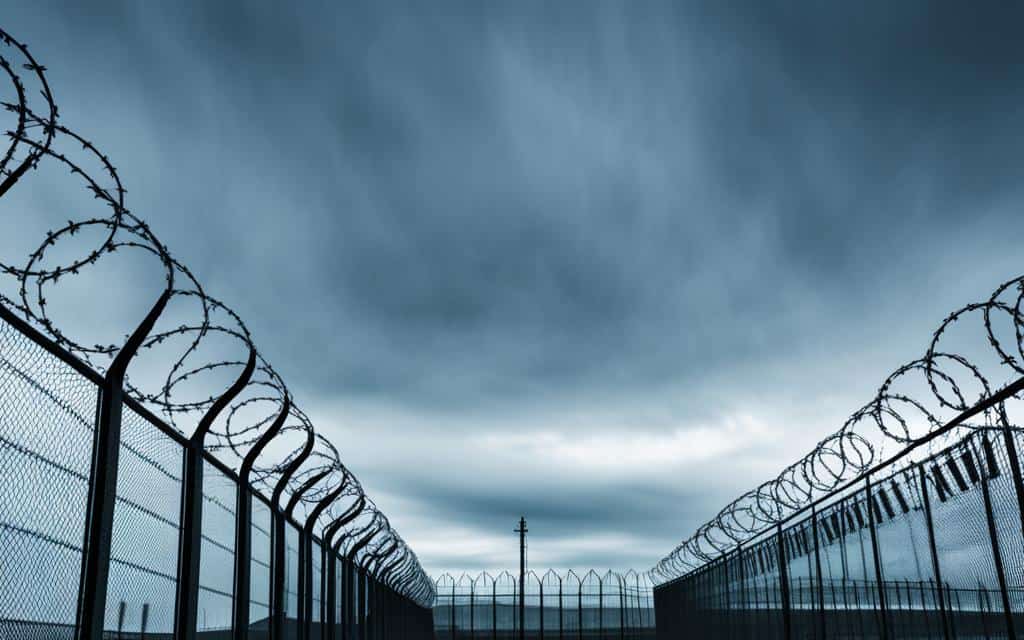Key Takeaways:
- Barbed wire finds applications in agriculture, security, construction, military, and more.
- It is extensively used in farming to create fences for livestock and protect crops.
- Barbed wire acts as a deterrent and enhances perimeter protection in security systems.
- It is prevalent in prison facilities to enhance security and inmate control.
- Barbed wire is employed in military applications for defense and border control operations.
Barbed Wire in Agriculture
Barbed wire plays a crucial role in the agricultural sector. Farmers utilize this versatile fencing material extensively to create fences and enclosures for livestock, ensuring the animals remain within specific areas while protecting valuable crops from potential damage caused by wandering livestock.
The use of barbed wire in agriculture provides several advantages. Firstly, it serves as a physical barrier, creating a clear boundary that helps farmers manage their livestock effectively. The barbs on the wire act as a deterrent, dissuading animals from attempting to breach the fence and roam freely.
In addition to containing livestock, barbed wire fences also prevent wild animals from entering agricultural areas, reducing the risk of crop destruction and potential financial losses for farmers. With the right installation and maintenance, barbed wire fences can be an effective solution for keeping animals in and unwanted visitors out.
Moreover, barbed wire fences are relatively easy to install and maintain, making them a cost-effective choice for farmers. They can be constructed quickly, allowing farmers to enclose vast areas efficiently. Routine inspections and basic repairs are essential to ensure the longevity and functionality of the fences, safeguarding the livelihood of livestock and the success of agricultural operations.
Overall, the use of barbed wire in agriculture demonstrates its versatility and practicality in the farming industry. It serves as a reliable and economical fencing solution, aiding farmers in securing their livestock and protecting valuable crops, ultimately contributing to a more efficient and prosperous agricultural sector.
Barbed Wire in Security
Barbed wire is a crucial component in security systems, serving to enhance perimeter protection and safeguard various types of properties. Its sharp and intimidating design acts as a powerful deterrent, effectively dissuading potential intruders from attempting unauthorized access.
The Role of Barbed Wire in Perimeter Protection
Barbed wire is strategically installed along fences and boundaries to create a formidable physical barrier. Its menacing appearance and piercing edges make it challenging for intruders to breach, effectively preventing trespassing and unauthorized entry.
In private properties, such as residential homes and commercial premises, barbed wire acts as the first line of defense against potential threats. It serves to demarcate the boundary, alerting individuals to restricted areas and deterring malicious intentions.
In industrial sites and high-security areas, barbed wire reinforces the protection measures in place, complementing other advanced security technologies. Its presence sends a clear message that unauthorized access will not be tolerated, heightening deterrence even further.
Applications of Barbed Wire in Security
Barbed wire finds extensive usage in a wide range of security applications. It is commonly employed in securing correctional facilities, airports, military installations, government buildings, and critical infrastructure. Its versatile nature allows it to adapt to various environments, making it a preferred choice in different security scenarios.
When used in conjunction with surveillance cameras, motion sensors, and alarm systems, barbed wire provides a comprehensive security solution. It acts as an additional layer of protection, further reinforcing the security infrastructure and mitigating potential risks.
Furthermore, barbed wire is considered particularly effective in securing outdoor areas and open spaces, such as construction sites, storage yards, and vacant properties. Its presence creates a visible deterrent, effectively dissuading potential intruders and reducing the risk of theft, vandalism, and unauthorized occupation.
Overall, barbed wire plays a vital role in the security domain, offering unmatched protection and deterrence. Its robust design, combined with its versatility and adaptability, makes it an indispensable tool in safeguarding private, commercial, and high-security premises.
Barbed Wire in Prison Facilities
The use of barbed wire is prevalent in prison facilities, where it is installed to enhance security and inmate control. The strategically placed barbed wire acts as an additional physical barrier, making escape attempts more difficult and discouraging prisoners from attempting to climb fences.
In correctional facilities, the primary concern is maintaining order and preventing unauthorized access. Barbed wire serves as a highly effective deterrent, preventing inmates from crossing boundaries and ensuring their confinement within the prescribed areas.
The implementation of barbed wire fencing in prisons has proven to be an essential element of inmate control. By reinforcing existing barriers, it contributes significantly to the overall security of the facility, reducing the risk of escape and enhancing the safety of both inmates and staff.
Correctional authorities strategically position barbed wire at the top of fences, walls, and other potential escape routes. This prevents unauthorized individuals from gaining access to the facility and restricts movement within the prison grounds.
Increased Deterrence and Safety
The presence of barbed wire acts as a visual reminder for inmates, emphasizing the consequences of attempting to breach the prison perimeter. It serves as a psychological deterrent, discouraging escape attempts and promoting discipline within the facility.
From a safety perspective, barbed wire contributes to the overall security of correctional facilities by restricting unauthorized access and preventing potential incidents. It acts as an effective physical barrier, making it challenging for inmates to scale fences or bypass established boundaries.
Moreover, the use of barbed wire in prison facilities aligns with the principles of inmate control and protects the public by ensuring that individuals convicted of crimes remain confined to their designated areas.
The use of barbed wire in prison facilities is an integral part of comprehensive security systems. It provides a robust physical deterrent and reinforces the overarching goal of maintaining inmate control and public safety.
Barbed Wire in Military Applications
Barbed wire has long been a staple in military applications, playing a vital role in defense strategies and securing sensitive areas. Its versatility and effectiveness make it an invaluable asset in war zones and border control operations.
In military contexts, barbed wire is deployed to create barriers and establish control over access points, restricting unauthorized movement and deterring potential threats. Its high-tensile strength and sharp edges make it difficult to penetrate, providing an additional layer of protection to military installations.
Barbed wire is extensively used in war zones to fortify perimeters, delineating boundaries, and preventing enemy incursions. It acts as a first line of defense, alerting soldiers to any attempted breaches and buying precious time to mount a response.
Border control operations heavily rely on barbed wire to secure international boundaries. It helps establish physical barriers, deterring illegal crossings and managing the flow of individuals and goods. Barbed wire serves as a visible reminder of the demarcated border, aiding in preventing unauthorized access and supporting border enforcement efforts.
Through its widespread use in military applications, barbed wire enhances defense capabilities, safeguarding military assets, and ensuring operational security. Its presence acts as a deterrent, dissuading potential threats and maintaining control over critical areas.
Barbed Wire in Construction and Safety
Construction sites prioritize safety, and one essential tool for creating secure environments is the use of barbed wire. This versatile solution offers several advantages in construction settings.
Firstly, barbed wire serves as a safety barrier, preventing unauthorized access to hazardous areas. By creating physical boundaries, construction sites can minimize the risk of accidents, injuries, and property damage.
Apart from establishing restricted zones, barbed wire acts as a visual warning, effectively deterring individuals from entering the construction site without proper authorization. Its prominent presence serves as a reminder of the potential dangers within the caution zones.
Moreover, barbed wire is an affordable and easily deployable solution, enabling construction sites to quickly establish secure perimeters. Whether it’s securing the site from trespassers or marking off restricted areas, barbed wire provides a reliable safety measure.
It’s important to note that construction site safety regulations may vary depending on the location and nature of the project. Therefore, it is crucial for construction managers and workers to familiarize themselves with the specific regulations and guidelines to ensure compliance.
Construction sites are dynamic and constantly changing environments, making regular inspections and maintenance crucial. Any damages to the barbed wire should be promptly repaired to maintain its effectiveness.
Barbed Wire in Animal Control
Barbed wire proves to be an effective tool in animal control efforts, especially in wildlife preservation and conservation areas. It plays a crucial role in maintaining boundaries, ensuring that certain animals do not encroach into protected habitats. By preventing unauthorized entry, barbed wire minimizes the risks of human-wildlife conflicts and helps preserve the delicate ecosystems.
Wildlife preservation and conservation areas are essential for safeguarding endangered species and maintaining biodiversity. These protected areas create a safe haven for animals and plants, enabling them to thrive without human interference. Barbed wire acts as a physical deterrent, discouraging animals from crossing into restricted zones and reducing the chances of habitat destruction.
The strategic placement of barbed wire fences helps establish clear boundaries, defining areas where human activity should be limited or prohibited. It acts as a visual barrier, guiding visitors and ensuring they stay within designated paths while minimizing disturbances to wildlife habitats.
When implemented responsibly, barbed wire in animal control contributes to the overall well-being of wildlife. It facilitates the management of conservation areas, allowing researchers and park authorities to monitor animal populations, control access, and implement necessary conservation measures.
Furthermore, the use of barbed wire in animal control emphasizes the importance of coexistence between humans and wildlife. By creating clear boundaries, it encourages humans to respect wildlife habitats and raises awareness about the significance of wildlife preservation and conservation.
As technology advances, there have been efforts to develop alternative fencing solutions that are more wildlife-friendly while still serving the purpose of animal control. These alternatives aim to minimize the impact on wildlife and ensure safer interactions between humans and animals.
Barbed Wire in Sports and Recreational Facilities
Sports facilities and recreational areas often utilize barbed wire as a crucial component of their security measures. The installation of perimeter fencing, which includes barbed wire, helps secure boundaries and prevent unauthorized entry, ensuring the safety of participants, spectators, and the general public.
Barbed wire serves as a visual deterrent, clearly defining designated areas and restricting access to authorized personnel only. By effectively delineating the boundaries of sports fields, stadiums, and recreational spaces, barbed wire helps maintain order, preventing unwanted visitors from encroaching upon the designated premises.
Whether it is a football field, tennis court, or a public park, the integration of barbed wire into the perimeter fencing system adds an extra layer of security to sports and recreational facilities. It acts as a physical barrier, discouraging individuals from attempting to bypass or climb fences, thus reducing the risk of accidents, disturbances, and unauthorized entry.
With safety being a top priority in sports and recreational activities, the implementation of barbed wire fencing provides peace of mind to event organizers, facility managers, and the general public. The robust design and high-tensile strength of barbed wire contribute to the resilience and durability of the security system, ensuring long-term protection and minimal maintenance requirements.
The Importance of Perimeter Fencing in Sports Facilities
Perimeter fencing, which incorporates barbed wire, is vital in sports facilities to prevent potential conflicts, safeguard valuable assets, and establish controlled access points. It plays a crucial role in maintaining order and facilitating smooth operations during events, competitions, and recreational activities.
By demarcating the boundaries of sports fields and recreational areas, perimeter fencing ensures fair play, minimizes interference, and enhances the overall experience for participants. It acts as a clear visual indicator, allowing athletes and individuals to concentrate on their activities without distractions.
Additionally, perimeter fencing with barbed wire reinforces spectator safety by preventing unauthorized access to restricted areas during events. It helps manage crowd control and ensure the secure separation of participants and spectators, minimizing the risk of injuries and potential conflicts.
Overall, barbed wire incorporated into perimeter fencing systems provides essential security and safety benefits to sports facilities and recreational areas, elevating the overall experience for everyone involved.
Impacts of Barbed Wire on Society
The introduction of barbed wire brought about both positive and negative consequences. On one hand, it enabled economic growth, supported boundary delineation, and promoted agricultural development. On the other hand, it created tensions among communities, disrupted migratory routes of wildlife, and generated conflicts over land and access rights.
The legacy of barbed wire extends beyond its practical applications. It holds a place in cultural and artistic representations, symbolizing human hardship and perseverance. Its presence in literature, film, and visual arts often evokes themes of confinement, restriction, and the resilience of the human spirit.
The historical significance of barbed wire then lies in its ability to transform landscapes, redefine ownership, and leave indelible marks on societies. By examining its past, we gain a deeper understanding of the complex interplay between technology, progress, and the evolving human relationship with the environment.
Maintenance and Safety Tips for Barbed Wire Enclosures
Proper maintenance and regular inspections are essential for ensuring the longevity and safety of barbed wire enclosures. By following the recommended safety measures and conducting timely repairs, you can minimize the risk of injuries and maintain the effectiveness of your barbed wire fences.
Regular Inspections:
Performing regular inspections of your barbed wire enclosures is crucial to identify any potential damage or wear. Inspect the entire length of the fence, checking for broken wires, loose fastenings, and weakened posts. Pay close attention to areas where the fence may have come into contact with harsh weather conditions or experienced excessive strain. Promptly address any issues encountered to prevent further deterioration.
Proper Repairs:
When repairs are necessary, it’s important to address them promptly. Replace any damaged or broken wires, ensuring they are tightly fastened. Repair or reinforce posts that show signs of weakness or instability. Utilize appropriate tools and materials to ensure secure repairs and maintain the structural integrity of the entire fence.
Safety Measures:
When working with barbed wire, always prioritize safety to avoid accidents and injuries. Wear appropriate personal protective equipment (PPE), such as gloves and eye protection, to shield yourself from potential hazards. Use caution when handling and installing barbed wire, paying attention to the sharp edges. Take steps to minimize the risk of entanglement or accidental contact, especially when working in confined spaces or adverse weather conditions.
Additionally, consider adding warning signs or markings to make others aware of the presence of barbed wire fencing. This ensures that people who are not familiar with the area are informed and can take the necessary precautions to avoid injuries.
By implementing proper maintenance practices, conducting regular inspections, performing timely repairs, and adhering to safety measures, you can ensure the effectiveness and safety of your barbed wire enclosures. Protect your property, livestock, and loved ones by maintaining secure and well-maintained barbed wire fences.



